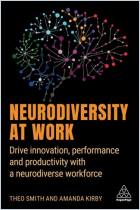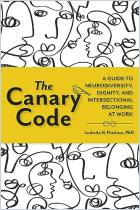加入 getAbstract 阅读摘要

加入 getAbstract 阅读摘要
Maureen Dunne
The Neurodiversity Edge
The Essential Guide to Embracing Autism, ADHD, Dyslexia, and Other Neurological Differences for Any Organization
Wiley, 2024
看看什么内容?
To drive innovation, companies must unleash the often untapped strengths of neurodivergent minds.
Recommendation
The innate strengths of neurodivergent workers are an often untapped resource that could help organizations drive innovation and navigate complex challenges. But according to cognitive scientist Maureen Dunne, organizations routinely exclude and overlook the potential of the roughly 20% of the population who are neurodivergent. Dunne explains how neurodiversity contributed to human survival in prehistoric times and how it can give companies a competitive edge today. Learn how to authentically include neurodiverse people in your workplace and gain insights into the strengths of divergent ways of thinking.
Take-Aways
- Organizations often display a bias toward the “neurotypical” status quo.
- View neurodivergence through a strengths-based lens – not a deficit lens.
- Teams that value “culture fit” may be glorifying “groupthink.”
- There’s a powerful economic argument for the authentic inclusion of neurodivergent workers.
- Become neurodivergent-friendly with more inclusive recruiting practices.
- Take strategic action to leverage the competitive advantage of cognitive diversity.
- Create a culture of empathy and mutual respect, overcoming the “double empathy problem.”
- Thrive in the Transformation Age by unleashing the power of the neurodivergent mind.
Summary
Organizations often display a bias toward the “neurotypical” status quo.
Roughly one in five people in the world today are “neurodivergent.” The term is a loose catch-all for cognitive differences attributed to the presence of neurological conditions such as ADHD, autism, dyslexia, dyspraxia, synesthesia, hyperlexia and dyscalculia. These differences do not, in themselves, speak to an individual’s intelligence or mental capacity. Neurodivergent people can be intellectually gifted or have intellectual disabilities, just like neurotypical people.
Despite comprising 20% of the population, neurodivergent individuals often struggle to navigate workplace systems that were not designed for them but, rather, for “neurotypical” people: those with cognitive profiles that more closely align with the statistical average. Neurodivergent individuals should feel valued for the vital cognitive diversity they can bring to the table, but many organizations fail to leverage their gifts and talents.
“At its core, complementary cognition strongly suggests that human cognition evolved to be complementary in order to promote cooperation and improve group performance.”
While many workplaces claim to be inclusive, their expectations as related to job performance, workplace roles and methods of working reveal otherwise. Workplaces that practice “inauthentic inclusion” push neurodivergent workers to “mask” or hide their authentic selves to fit in with neurotypical assumptions and standards. Organizations with a neurotypical bias may believe this status quo produces the best results. Still, evidence suggests that “neurodiverse” communities – those populated by both neurotypical and neurodivergent people – possess a competitive advantage.
“Complementary cognition” – the diverse ways of thinking and problem-solving prevalent in neurodiverse groups – helps the group as a whole to navigate complex situations and adapt to evolving environments more effectively. Indeed, many researchers posit that complementary cognition was a vital component of human survival in prehistoric times.
View neurodivergence through a strengths-based lens – not a deficit lens.
It’s time to start viewing neurodivergence through a strengths-based lens rather than seeing difference as a deficit. In fact, there are several advantages associated with neurodiversity. People with autism often demonstrate superior pattern-detecting skills and less susceptibility to biased thinking. Individuals with dyslexia tend to excel at noticing connections between otherwise disparate concepts, perspectives or objects. Those with ADHD demonstrate heightened levels of original thinking and cognitive flexibility. Even when neurodivergent people do not demonstrate exceptional abilities, they still bring value to their organizations: Groups that consistently include neurodivergent people develop stronger cooperation skills and more creative problem-solving skills over time.
“Authentic inclusion is fundamentally about maximizing what any given individual can contribute within an organization and doing so in a way that appreciates and values diversity.”
Think of yourself as living in “Neurodiversity World 1.0” today – a world where many neurodivergent individuals lack the opportunities to contribute meaningfully to their communities. Embrace the shift to “Neurodiversity World 2.0” by being more authentically inclusive of neurodiversity. Making this shift requires reflecting on your core values as an organization – the ones that govern how you invest time, money and resources every day, as opposed to the ones you publicly associate with your brand. Hiring managers, leaders and administrators make choices every day that either keep their organizations trapped within the limitations of World 1.0 or help them expand into World 2.0. Commit to actively valuing and respecting diversity and supporting workers in reaching their full potential.
Teams that value “culture fit” may be glorifying “groupthink.”
Research indicates that neurotypical people tend to have more confidence in decisions when there’s group consensus, yet this confidence is often unwarranted. You might assume that a group’s decision-making process leverages the collective sum of each member’s experience, intellect and knowledge. However, decisions within teams of neurotypical people are often the result of groupthink: The group makes choices based on the consensus they sense emerging rather than via critical reasoning. Your team may be suffering from groupthink if you notice the following: extremely high levels of group cohesion; failure to evaluate new and divergent ideas critically; delusions of group invulnerability, unanimity; group members pressuring dissenters to conform; self-censorship; and the stereotyping of those you view as outsiders.
“Sometimes, all it takes in a group decision-making process is one or two people either noticing an alternate path to progress or failing to be influenced by a popular but irrational choice and then speaking up against a dominant view to introduce new angles or perspectives into the group decision-making process.”
Neurodivergent team members tend to prevent groupthink, as research suggests that they maintain their capacity to think independently, even when others pressure them to conform. Neurotypical people, by contrast, tend to prioritize their status within group hierarchies over independent thought and honesty. Organizations often celebrate neurotypical groupthink – framing it as “culture fit.” But prioritizing cohesion at the expense of critical thought is a surefire path to stagnation and irrelevancy. When teams fail to explore ideas and possibilities that fall outside their comfort zones, it prevents them from properly detecting and assessing risks.
There’s a powerful economic argument for the authentic inclusion of neurodivergent workers.
In the United States, there are roughly 60 million neurodivergent individuals, many of whom struggle with unemployment and underemployment due to a lack of workplace support and widespread neurotypical bias. The unemployment rate for people with dyslexia is around 50%, and around 30% for people with ADHD. By contrast, in the general population, the unemployment rate is under 4%.
The United States is already facing a labor crisis. According to the Federal Reserve, the factors shaping the current US labor shortage – a rapidly aging population and a decrease in immigration – are unlikely to change in the foreseeable future. As older employees leave the workforce, your company could face even tighter margins and increased costs.
“Given that the demand for workers is relatively steady over time, a structural shortage in the supply of workers is bound to lead to structural upward pressures on labor costs and a margin squeeze.”
Workers are beginning to grasp the power that they possess. Some advocate “quiet quitting” – or committing to doing only the bare minimum in their roles – while others are “rage applying” everywhere they can due to job dissatisfaction and a lack of engagement. In the face of this changed dynamic, employers must begin considering new pools of potential workers and ways to accommodate their diverse needs.
Become neurodivergent-friendly with more inclusive recruiting practices.
You can make your recruiting practices more neurodivergent-friendly and, thus, increase your company’s neurodiversity in the following ways:
- Embed cognitive diversity into your core values – Create a values statement reflecting your commitment to neurodivergent workers. Ensure genuine buy-in from those in power throughout your organization.
- Identify recruitment challenges – Conduct an audit to identify any barriers to recruiting neurodivergent people. For example, your company might ignore the potential value of neurodivergent workers who’ve had periods of underemployment or unemployment.
- Embrace alternative interview formats – If you’re looking for someone who excels at analyzing data or is a cybersecurity expert, why evaluate them based on whether they demonstrate strong conversation skills in an interview? Consider other approaches, such as task-based interview processes, that allow candidates to demonstrate their skills.
- Form partnerships – Grow your organization’s talent pipeline through partnerships with organizations such as nonprofits and universities.
- Use a “Complementary Skills Matrix Organizational Framework” – Rather than aiming to hire people who can do anything, recruit workers with skills that complement those already within your organization. This approach gives your company greater adaptability and empowers workers to achieve greatness in the areas where they’re most skilled.
Take strategic action to leverage the competitive advantage of cognitive diversity.
Leaders can create an authentically inclusive workplace by doing the following:
- Nurture psychological safety – A psychologically safe work environment is foundational to inclusivity. Leaders should nurture a culture of belonging and acceptance of differences and actively discourage belittling or dismissive attitudes toward neurodivergent workers. None of your pro-neurodiversity policies will matter if people don’t feel safe unmasking and being their authentic selves.
- Accommodate neurodivergent workers in the office – Apply universal design principles – which ensure the comfort, and support the preferences of, as many employees as possible – to ensure neurodivergent team members thrive in your workplace. You might, for example, offer quiet spaces within the office and ask about workers’ preferred communication methods. Include neurodivergent team members in discussions about how to create more optimal work environments.
- Embrace flexibility – Respect the autonomy and needs of your neurodivergent workers by embracing flexible or hybrid work models. Extend supportive resources and clarify team members’ responsibilities when working remotely.
- Be authentically inclusive at all levels – Help neurodivergent workers identify opportunities for advancement and seek to include neurodivergent people in your leadership team.
Create a culture of empathy and mutual respect, overcoming the “double empathy problem.”
Both neurotypical and neurodivergent people struggle to understand and empathize with “the other.” Autism researcher Damian Milton first used the term “double empathy problem” to describe this issue in 2012. Milton argued – and other researchers, such as Elizabeth Sheppard and Noah Sasson and their respective teams, have independently affirmed – that non-autistic people struggle to understand the mental states and emotions of autistic people just as much as autistic people do with neurotypical people. For example, a neurotypical person may judge an autistic person harshly for not displaying much enthusiasm during small talk.
“Neurotypical people have just as much trouble understanding the intentions and perspectives of autistic people as autistic people have in accurately deciphering the minds of neurotypical people.”
Overcoming the “two-way empathy barriers” between autistic and neurotypical people requires a concerted effort on both sides. Team leaders can support teams in building “empathy bridges” between those with different cognitive profiles by facilitating perspective-taking exercises during workshops, retreats and training sessions. This could look like using virtual reality headsets to help those who don’t experience sensory overload understand the experiences of neurodivergent individuals who do experience it. While you can’t realistically expect all team members to like one another, you can create a culture of expanded understanding across neurotypes, thus helping people feel a sense of empathy and respect for those different from themselves.
Thrive in the Transformation Age by unleashing the power of the neurodivergent mind.
Being neurodivergent can feel lonely and isolating. As one man with autism and ADHD explains, it can feel like everyone around you is connected “by some invisible telepathic field.” Their brains share the same metaphorical network, but you lack access to that network. He calls this invisible mind-to-mind connection the “Mi-Fi” network.” Becoming an organization that’s authentically inclusive to neurodivergent people means ensuring that “absolutely everyone has access to the Mi-Fi network.”
Building understanding between neurotypical and neurodivergent people involves effort on both sides, including clear, open communication about how the individuals involved experience a shared event or situation. For example, a neurodivergent person might be more upset by the sound an air conditioner makes than the coldness of the office. Meanwhile, a neurotypical person may not notice the machine’s sound but be bothered by the cold. These two people are experiencing the same set of circumstances in vastly different ways. If they don’t grasp that possibility, it could lead to misunderstandings.
“This is the moment to embrace authentic neurodiversity inclusion as a core organizational value. It isn’t the whole solution to anything. But it is part of the solution to nearly everything.”
In the Transformation Age, an era where rapid change and a lack of predictability have become the norm, the organizations that thrive and have a competitive edge in the future may be those that successfully harness the power of neurodivergent minds. Those who engage in lateral and associative thinking can often view problems from alternate perspectives, as they think in a non-linear way that can lead to unexpected breakthroughs. When combined with AI’s processing power and speed, neurodiverse companies can discover new productivity pathways and disruptive solutions.
About the Author
Dr. Maureen Dunne is a cognitive scientist and a neurodiversity expert.
This document is restricted to personal use only.




















Comment on this summary